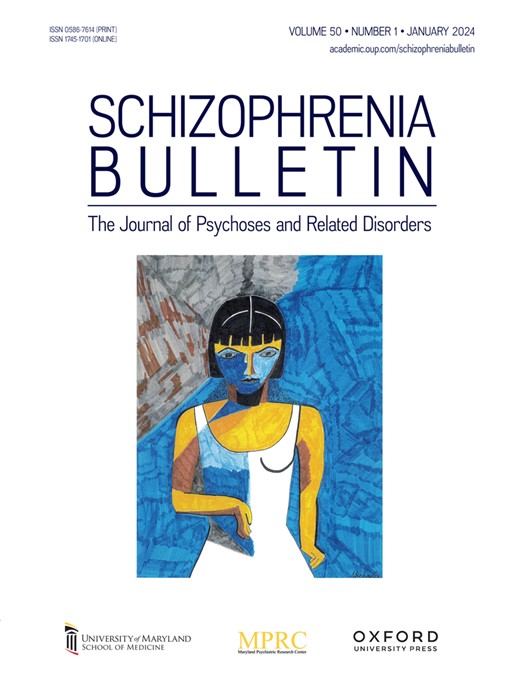Potential Delayed Positive Effects of tDCS on Improving Introspective Accuracy in Social Cognition in Schizophrenia
IF 5.3
1区 医学
Q1 PSYCHIATRY
引用次数: 0
Abstract
Background and Hypothesis Impairments in introspective accuracy (IA) are prominent among schizophrenia patients and detrimentally affect daily functioning, making IA a potential therapeutic target. Recent research highlights the role of the right rostrolateral prefrontal cortex (rlPFC) in IA and suggests that transcranial direct current stimulation (tDCS) to this region may improve it. Therefore, we tested whether applying tDCS to the right rlPFC could enhance IA for schizophrenia patients and explored the potential order/delayed effects. Study Design A randomized, double-blind, sham-controlled crossover design was used. Patients with a schizophrenia spectrum disorder (N = 40) underwent 2 tDCS sessions targeting right rlPFC (one was active stimulation and the other was sham) about a week apart. After each session, participants completed executive function and emotion recognition tasks for evaluating IA. Study Results When ignoring order effects, tDCS did not affect performance, IA, or confidence ratings across 3 tasks, except for increased confidence ratings in the cognitive task after active stimulation versus sham. However, considering order effects revealed significant interaction effects between condition and order for both task performance and IA. The group receiving active stimulation at visit 1 (Active First) generally improved over time in both cognitive and social cognitive task performance and in social cognitive IA, specifically for emotion recognition ability. In contrast, the group receiving sham stimulation at visit 1 (Sham First) showed no change in performance or IA over time. Conclusions Our findings provide preliminary evidence for potential positive, but delayed, effects of tDCS in improving task performance and IA in schizophrenia.求助全文
约1分钟内获得全文
求助全文
来源期刊

Schizophrenia Bulletin
医学-精神病学
CiteScore
11.40
自引率
6.10%
发文量
163
审稿时长
4-8 weeks
期刊介绍:
Schizophrenia Bulletin seeks to review recent developments and empirically based hypotheses regarding the etiology and treatment of schizophrenia. We view the field as broad and deep, and will publish new knowledge ranging from the molecular basis to social and cultural factors. We will give new emphasis to translational reports which simultaneously highlight basic neurobiological mechanisms and clinical manifestations. Some of the Bulletin content is invited as special features or manuscripts organized as a theme by special guest editors. Most pages of the Bulletin are devoted to unsolicited manuscripts of high quality that report original data or where we can provide a special venue for a major study or workshop report. Supplement issues are sometimes provided for manuscripts reporting from a recent conference.
 求助内容:
求助内容: 应助结果提醒方式:
应助结果提醒方式:


